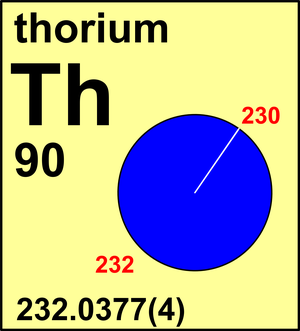Thorium
| Isotope | Atomic mass (Da) | Isotopic abundance (amount fraction) |
|---|---|---|
| 230Th | 230.033 132(8) | 0.0002(2) |
| 232Th | 232.038 05(1) | 0.9998(2) |
Thorium has been considered a monoisotopic element in the past. However, owing to significant abundance of its minor isotope 232Th in deep-seawater, in 2013, the Commission recognized thorium as an element with two naturally-occurring isotopes and recommended Ar(Th) = 232.0377(4).
232Th is an α-emitter with a half-life of 1.40(1)×1010 a, decaying through a branched series to 208Pb without very long-lived intermediate isotopes. 230Th is a nuclide in the 238U decay series. It has a half-life of 7.54(2)×104 a, and is formed by α-decay of 234U.
By virtue of its long half-life, about 80 % of the 232Th present when the Earth was formed survives to this time. 230Th is not generally found in substantial amounts in normal sources of thorium, but it is readily detected in deep-seawater. The 232Th-208Pb decay scheme is of value to geochronology.
Atomic weights of the elements: Review 2000 by John R de Laeter et al. Pure Appl. Chem. 2003 (75) 683-800
Atomic Weights of the Elements 2013 by Juris Meija et al. Pure Appl. Chem. 2016 (88) 265-291

CIAAW
Thorium
Ar(Th) = 232.0377(4) since 2013
The name derives from Thor, the Scandinavian god of thunder. It was discovered in the mineral thorite
(ThSiO4) by the Swedish chemist Jöns Jacob Berzelius in 1828. Thorium was first isolated by the chemists D.
Lely, Jr. and L. Hamburger in 1914.


